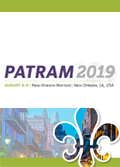 |
|
 |
 |
 |
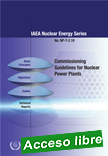 |
Commissioning Guidelines for Nuclear Power Plants
IAEA Nuclear Energy Series, 2018, 133 p.
Commissioning is one of the key steps towards putting into service a new nuclear facility, or a new system, structure or component within an existing facility. Commissioning activities need to be planned early in the design and procurement process, with careful consideration of eventual acceptance criteria and test methods. |
This publication describes commissioning in its basic form, the commissioning process specific to nuclear power plants (NPPs), the relevant management system requirements, typical organizational models and critical human resources issues. It also provides details on experience and lessons learned obtained in Member States. The publication will be of use to all stakeholders involved in the commissioning of NPPs, including owner operators, contractors, engineers, regulatory bodies and vendors.
|
 |
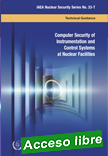 |
Computer Security of Instrumentation and Control Systems at Nuclear Facilities - Technical Guidance
IAEA Nuclear Security Series, 2018, 58 p.
Computer Security as a discipline is challenged by increasing threat vectors targeting a dynamic technological environment. This publication establishes guidance addressing the challenge of applying computer security measures to instrumentation and control (I&C) systems at nuclear facilities. The measures are intended to protect these I&C systems throughout their entire lifecycles against malicious acts perpetrated by threat actors. |
The technical basis and methodologies for the application of these computer security measures are considered. The publication also addresses the application of such measures to the development, simulation and maintenance environments of these I&C systems. In addition, account is taken of developments in human factors engineering and nuclear safety. This Technical Guide references and takes into account other Safety Guides and IAEA Nuclear Security Series publications that provide guidance relating to I&C design.
|
 |
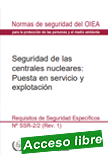 |
Seguridad de las Centrales Nucleares: Puesta en Servicio y Explotación
OIEA Requisitos de Seguridad Específicos, 2018, 80 p.
El objetivo de esta publicación es determinar los requisitos que, a la luz de la experiencia y el estado actual de la tecnología, deben cumplirse para garantizar la puesta en servicio y la explotación seguras de las centrales nucleares. Estos requisitos se rigen por el objetivo y los principios de seguridad establecidos en los Principios Fundamentales de Seguridad.
|
|
 |
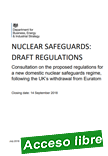 |
Nuclear Safeguards Regulations: consultation
Department for Business, Energy & Industrial Strategy (UK), July 2018, 90 p.
The draft Nuclear Safeguards Regulations will enable a new domestic nuclear safeguards regime to operate in the United Kingdom, following the UK’s withdrawal from the European Atomic Energy Community (“Euratom”) which will occur as a consequence of leaving the European Union. This domestic regime will replace the current arrangements provided by the UK’s membership of Euratom, and by the European Commission’s role in the trilateral agreements between the International Atomic Energy Agency, the UK and Euratom. |
The Government has committed to establishing a new regime which will be equivalent in effectiveness and coverage to that currently provided by Euratom, and which will exceed expected international standards. The Government’s approach is to establish a regime that will operate in a similar way to the existing arrangements, meeting the UK’s international commitments as applied in the new bi-lateral agreements with the International Atomic Energy Agency. The approach takes account of best practice in UK regulation making and reflects feedback on the practical, regulatory and operational needs of our stakeholders, including the need to minimise disruption to industry. If passed into law, these proposed draft Nuclear Safeguards Regulations will allow the Office for Nuclear Regulation to deliver international standards from day one of exit, and to build, over time, to Euratom equivalence.
A number of changes have been incorporated into the draft Nuclear Safeguards Regulations to ensure they are appropriate for the domestic, legislative and operational landscape in which they operate. They will take account of and align with best practice and reflect the difference between a system regulated by a national regulator and the application of safeguards by a supranational body (e.g. introducing an accountancy and control plan and formalising compliance with international cooperation agreements) or develop upon existing practice (e.g. special provisions for a qualifying nuclear facility with limited operation).
The draft Nuclear Safeguards Regulations reflect debates on nuclear safeguards in Parliament and incorporate feedback from the nuclear industry and wider stakeholder community obtained through our discussions on safeguards at the Euratom Industry forums in September 2017 and March 2018. The next Euratom Industry Forum is planned for 19 July 2018 and will provide a further opportunity for the industry to provide feedback in addition to the planned consultation workshops outlined in the ‘How to Respond’ section below.
The draft Nuclear Safeguards Regulations will be made under the powers contained in the Nuclear Safeguards Act 2018 and the Energy Act 2013 (as amended). The Nuclear Safeguards Act 2018 provides for the Office for Nuclear Regulation to take on the role and responsibilities required to ensure compliance with nuclear safeguards obligations contained in a relevant international agreement, whether with the International Atomic Energy Agency or with a third country. The Office for Nuclear Regulation already regulates nuclear safety and security.
|
 |
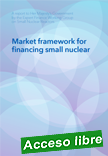 |
Advanced Nuclear Technologies - Information about Advanced Nuclear Technologies, Market framework for financing small nuclear
Expert Finance Working Group (EFWG - UK), 7 August 2018, 80 p.
In December 2017 government announced the creation of the Expert Finance Working Group on Small Reactors to advise on how small nuclear reactor projects could raise investment in the UK. |
The group, chaired by Fiona Reilly (Executive Partner, Atlantic SuperConnection and a Non-executive Director of the Nuclear Industry Association), sets out in the report a series of recommendation on how government, the nuclear and the finance sector can work together to enable the advanced nuclear technologies market.
These include: setting out a clear policy and market framework; integrating energy, nuclear and finance sector stakeholders; focusing on bringing first-of-a-kind (FOAK) projects to market
establishing an advanced manufacturing supply chain initiative; optimising the Generic Design Assessment (GDA) process; making sites available to FOAK small nuclear projects;
setting out a new infrastructure fund.
|
 |
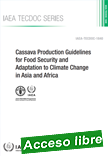 |
Cassava Production Guidelines for Food Security and Adaptation to Climate Change in Asia and Africa
IAEA TECDOC, 2018, 76 p.
Cassava is the third largest source of human food and animal feed carbohydrates in the tropics, after maize and rice. It is a major food crop in Africa and also grown in a number of countries in Asia. However, declining soil fertility and poor farming practices are serious problems for traditional cassava farms in both Asia and Africa. This publication is intended to assist Member States in enhancing their cassava production.
|
It provides information on the best farm management practices and the role of nuclear and isotopic techniques to better understand nutrient nitrogen (N) uptake. The guidelines presented in the publication provide an integrated and crop-need-based nutrient, weed, insect pest and disease management plan for growing cassava. By using these improved crop management methods, farmers can optimize cassava yields and minimize production costs. They also contribute to a reduction in land degradation by soil erosion, particularly on sloping lands, thereby protecting the local environment. The intended end result is an enhancement of the quality and market value of cassava products.
|
 |
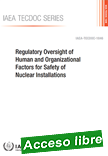 |
Regulatory Oversight of Human and Organizational Factors for Safety of Nuclear Installations
IAEA TECDOC, 2018, 66 p.
Written for use by regulatory bodies and their technical support organizations, and those individuals supporting human performance activities and programmes, this publication addresses the definition and implementation of an oversight programme that adequately takes into account human and organizational factors (HOF) to oversee safety throughout the lifetime of nuclear installations. |
A key concept is that safety is the result of interaction between humans, technology and the organization. Based on the outcome of several international meetings, this publication presents the main elements to be used to enhance regulatory oversight capabilities and describes the essential concepts and terms used in the area of HOF. It is intended to help in the development of regulations and guides related to HOF, stressing the key role of the licensee's management system in establishing and maintaining conditions to support people at work. The TECDOC describes ways to verify compliance with regulatory requirements related to HOF, as well as ways to better understand HOF trends and conclusions, using an integrated safety assessment approach.
|
 |
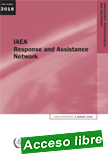 |
IAEA Response and Assistance Network
IAEA Emergency Preparedness and Response, 2018, 158 p.
This publication describes the mechanism for: Facilitating the provision of international assistance in a nuclear or radiological emergency, regardless of its origin; Cooperation between States, their Competent Authorities and the IAEA Secretariat in case international assistance is requested; Promoting and supporting cooperation between States to coordinate the
provision of assistance to a requesting State;
|
; Harmonization of response capabilities of States offering assistance under the Response and Assistance Network (RANET).
The publication may also assist Competent Authorities and other response
organizations in their efforts to establish and/or maintain their own emergency response
capabilities.
|
 |
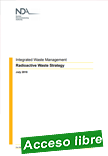 |
Integrated Waste Management - Radioactive Waste Strategy
Nuclear Decommissioning Authority (UK), July 2018, 37 p.
In the 2016 NDA Strategy we made a commitment to develop a single radioactive waste strategy for the NDA Group. This strategy applies to all radioactive waste generated within the NDA estate, (including materials that may become waste at some point in the future). The radioactive waste strategy provides a high level framework within which waste management decisions can be taken flexibly, to ensure safe, environmentally acceptable and cost-effective solutions that reflect the nature of the radioactive waste concerned.
|
A single radioactive waste strategy provides a consolidated position and greater clarity of our strategic needs in this area; promotes cross-category waste management opportunities; supports a risk-based approach to waste management and provides an integrated programme to deliver suitable and timely waste management infrastructure to support the NDA mission. The strategy articulates our strategic positions and preferences against each of the waste management lifecycle stages: planning and preparation; treatment and packaging; storage; disposal To implement this strategy we will create an integrated programme which will build upon the success of the Low Level Waste (LLW) programme. The integrated programme will seek to drive changes in waste management behaviour and culture to allow waste producers to flexibly and effectively manage their radioactive waste as well as develop proportionate waste management solutions. The programme will be implemented in prioritised phases with the initial focus on areas such as wastes at the LLW/ILW boundary, waste management culture and packaging. This will deliver benefits through the provision of a more integrated approach to radioactive waste management; development of proportionate, risk based waste management approaches; better coordination across the industry and reduced lifecycle costs.
|
 |
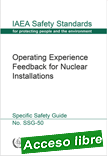 |
Operating Experience Feedback for Nuclear Installations
IAEA Safety Standards Series, 2018, 45 p.
The objective of this Safety Guide is to provide recommendations for establishing, implementing, assessing and continuously improving an operating experience programme for nuclear installations to prevent or minimize the risk of future events3 by learning from events that have already occurred at the installation or elsewhere.
|
This Safety Guide is primarily aimed at operating organizations and regulatory bodies responsible for nuclear installations and describes their roles and responsibilities in the overall operating experience programme. However, this Safety Guide is also of relevance to other organizations involved in the design, construction, commissioning, operation and decommissioning of nuclear installations, including technical support organizations, vendor companies (e.g. designers, engineering contractors, manufacturers), research establishments and universities providing research and safety related services in support of a nuclear facility.
|
 |
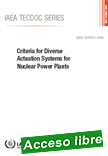 |
Criteria for Diverse Actuation Systems for Nuclear Power Plants
IAEA TECDOC, 2018, 96 p.
This publication addresses a safety concern within the protection system for nuclear power plants that might result in unacceptable consequences for certain combinations of common cause failures and postulated initiating events, especially in case of programmable digital protection systems. When this situation is encountered, a diverse actuation system is often provided to back up the reactor protection system.
|
The publication identifies and discusses common criteria for the design of diverse actuation systems at nuclear power plants (NPPs) with the aim of developing a consensus on the adequate level of diversity in the reactor protection systems. It relates to IAEA Safety Standards Series No. SSG-39, Design of Instrumentation and Control Systems for Nuclear Power Plants, and provides specific details for utility engineers, operators, researchers, managers, and personnel responsible for all aspects of design and implementation of instrumentation and control systems of diverse actuation systems for NPPs. It will also aid Member States to support assessment of diversity in I&C architecture as a defence against common cause failures.
|

|
|
|
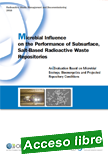 |
Microbial Influence on the Performance of Subsurface, Salt-Based Radioactive Waste Repositories
Nuclear Energy Agency (NEA), 22/05/18, 72 p.
For the past several decades, the Nuclear Energy Agency Salt Club has been supporting and overseeing the characterisation of rock salt as a potential host rock for Deep geological repositories. This extensive evaluation of deep geological settings is aimed at determining ? through a multidisciplinary approach ? whether specific sites are suitable for radioactive waste disposal.
|
Studying the microbiology of granite, basalt, tuff, and clay formations in both Europe and the United States has been an important part of this investigation, and much has been learnt about the potential influence of microorganisms on repository performance, as well as about deep subsurface microbiology in general. Some uncertainty remains, however, around the effects of microorganisms on salt-based repository performance. Using available information on the microbial ecology of hypersaline environments, the bioenergetics of survival
under high ionic strength conditions and studies related to repository microbiology, this report summarises the potential role of microorganisms in salt-based radioactive waste repositories.
|
| |
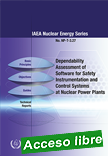 |
Dependability Assessment of Software for Safety Instrumentation and Control Systems at Nuclear Power Plants
IAEA Nuclear Energy Series, 2018, 80 p.
This publication defines a framework that represents the state of the art in assessment methodologies for safety and instrumentation and control software used at nuclear power plants. It describes an approach for developing and communicating assessments based on claims, argument and evidence.
|
The assessment of software dependability, which encompasses properties such as safety, reliability, availability, maintainability and security, is an essential and challenging aspect of the safety justification. Guiding principles for a dependability assessment are established to provide the basis for defining an assessment strategy and implementing the assessment process. Sources of evidence for the assessment are provided and lessons learned from past digital instrumentation and control system implementation in areas such as software development, operational usage, regulatory review and platform certification are also described.
|
| |
| |
|
|
| |
| |
|
|
|
|
|
|
|

